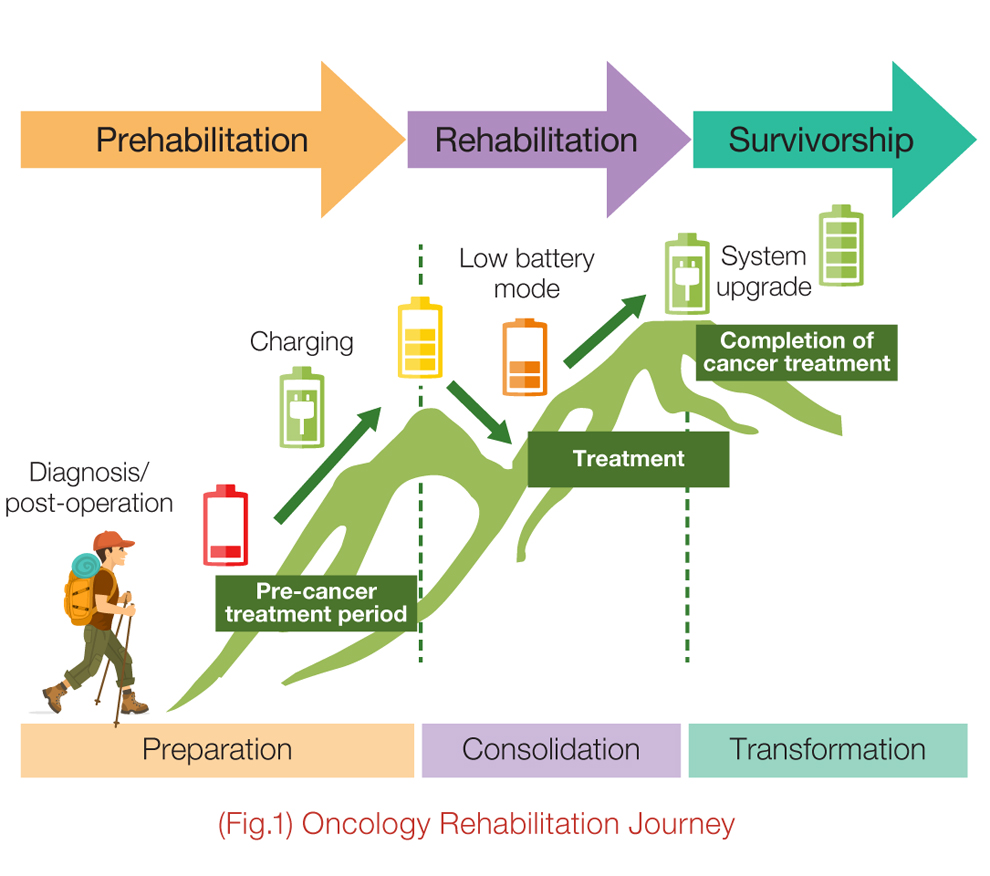HKSH Mobile App | Wechat Booking
Request an Appointment | Online Booking
Prehabilitation and Rehabilitation
1. Benefits of Physical Activity
It is evident that physical activities are beneficial to cancer patients. Exercise will improve cancer-related fatigue, physical fitness, muscle strength, lymphedema and reduce joint stiffness. The benefits are especially prominent in patients with breast, prostate and hematologic cancers.
During active cancer treatment, a decrease in fitness level is inevitable. Prehabilitation helps patients to prepare the mind and body to function at full potential before undergoing the tough and energy-draining cancer treatment. It is like charging a “battery” before a mountain run (Figure 1). Exercise helps maintain as much functional independence as possible and reduce unnecessary disability. It offers an effective route to improve quality of life. The exercise intensity level can be monitored with heart rate measurement and the Borg Scale.

2. What is cancer-related fatigue?
Cancer-related fatigue is a common problem. It means extreme tiredness most or all the time. It is not relieved by rest or sleep and can affect you physically and emotionally. It can be very disruptive and makes it difficult to do even very simple things, e.g. getting dressed.
3. When is the best time to start exercise?
i. Once cancer is diagnosed and before any active treatment
ii. After surgery but before any high-intensity cancer treatment. This is another good starting point if patients are not able to start exercise before surgery In general, it takes at least two weeks of exercise training to show improvement in the cardiovascular system, muscle strength and functional ability.

It is evident that physical activities are beneficial to cancer patients. Exercise will improve cancer-related fatigue, physical fitness, muscle strength, lymphedema and reduce joint stiffness. The benefits are especially prominent in patients with breast, prostate and hematologic cancers.
During active cancer treatment, a decrease in fitness level is inevitable. Prehabilitation helps patients to prepare the mind and body to function at full potential before undergoing the tough and energy-draining cancer treatment. It is like charging a “battery” before a mountain run (Figure 1). Exercise helps maintain as much functional independence as possible and reduce unnecessary disability. It offers an effective route to improve quality of life. The exercise intensity level can be monitored with heart rate measurement and the Borg Scale.

2. What is cancer-related fatigue?
Cancer-related fatigue is a common problem. It means extreme tiredness most or all the time. It is not relieved by rest or sleep and can affect you physically and emotionally. It can be very disruptive and makes it difficult to do even very simple things, e.g. getting dressed.
3. When is the best time to start exercise?
i. Once cancer is diagnosed and before any active treatment
ii. After surgery but before any high-intensity cancer treatment. This is another good starting point if patients are not able to start exercise before surgery In general, it takes at least two weeks of exercise training to show improvement in the cardiovascular system, muscle strength and functional ability.

FRAUD ALERT: Reports have been received from the public about fraudulent calls impersonating Hong Kong Sanatorium & Hospital, falsely claiming uncollected medical documents. Do not respond or share personal information. Please be aware of bogus communications (fraudulent websites, emails and phone calls) purportedly from HKSH Medical Group or its members including Hong Kong Sanatorium & Hospital, HKSH Healthcare, HKSH Eastern Medical Centre, HKSH Cancer Centre and affiliates. Do not disclose any personal information to suspicious calls. Please call HKSH Medical Group at 2572 0211 if you have any concerns.





